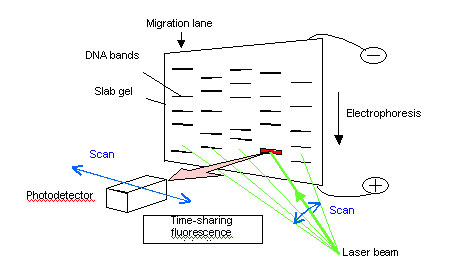Genome Analysis

Slab Gel DNA Sequencer using Scanning Laser-beam Irradiation Method
A DNA sequencer is made of a slab of gel with electrophoresis migration paths sandwiched between two planes of glass. Different DNA samples are inserted into each migration path and move under the influence of electrophoresis.
The DNA samples are made of DNA fragments of varying lengths that are marked by fluorophore tags. When a voltage is applied between the top and bottom edges of the slab gel, the negatively charged DNA fragments migrate to the positive terminal. The migration speed depends partly on the length of DNA fragments - the shorter the fragment, the faster it will migrate under electrophoresis. Therefore, the DNA fragments form a bar-code-like pattern in the slab gel as the shorter fragments separate from the longer fragments.
A laser is aimed at a fixed distance along the migration path of DNA fragments. The laser excites the fluorophore tags on the DNA fragments as they traverse the irradiated region, starting with short fragments in order of their length. Fluorescence emission from the excited fluorophore tags is then detected by a photo-detector and analyzed to determine the base sequence of the DNA sample.
As shown in the figure, the laser beam is aimed at different positions on the slab gel sequentially. Repeated scans of irradiation positions allow the photo-detector to measure fluorescence emissions from multiple electrophoresis migration paths in order, and determine the base sequence of multiple DNA samples.
Time-sharing fluorescence detection using laser scans in this manner, however, suffers from several drawbacks. First, as the number of migration paths increase, the photo-detector must scan each migration path faster. This shortens the fluorescence detection period per migration path and lowers the sensitivity of fluorescence detection. Second, the complexity of the scanning mechanism often leads to malfunctions.
To address these and other issues, Dr. Kambara developed a slab gel DNA sequencer with "side-entry laser irradiation" technology.